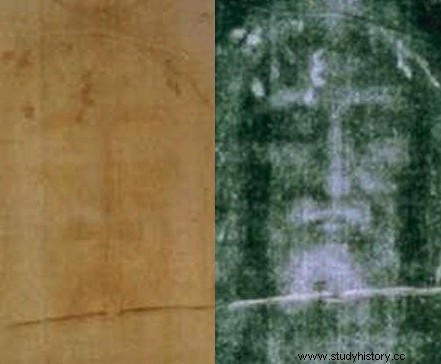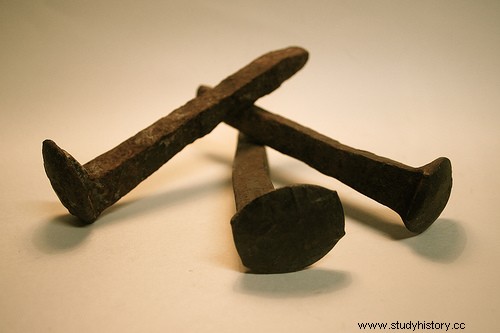Around relics, such as body parts of saints or objects that have been in contact with them, it has always been considered whether behind them there is a historical reality and a scientific basis that can demonstrate, at least, their antiquity or, simply, it is fruit of excessive devotion and smoke sellers who wanted to make some profit. This is one of the most important relationships related to Jesus Christ:
Holy Shroud or Shroud .
It is located in the cathedral of Turin. The best known of all and on which more studies have been done, above all, to know its antiquity. It is a linen cloth with which the body of Jesus Christ is supposed to be covered when it was buried and in which his face was captured. After the Carbon 14 test, the study of pollen grains, digitizing the image and many more tests, no agreement has been reached on its veracity. In Spain, in the cathedral of Oviedo, we have the Oviedo scarf which was revered as the small shroud that covered his head.

The Veil of Veronica.
It is located in Saint Peter's Basilica in Rome. While Jesus Christ carried the cross, on the way to Mount Calvary where he would be crucified, he stopped at the sixth station of the Way of the Cross to rest and Saint Veronica approached to wipe the sweat from her face, leaving it imprinted on the small cloth. The history of this relic is not known until well into the Middle Ages and no study has been carried out on it. During the 20th century, only the Jesuit and art historian José Wilpert he has been able to contemplate it without the protection that covers it and his words do not leave anything clear either «a square piece of a light-colored material, faded by age, which bears two faint brown rust stains connected one to the other «. Today 3 more are venerated, two of them in Alicante and Jaén.

Representation of Veronica - Greco
The Holy Chalice.
It is located in the cathedral of Valencia. The Holy Chalice, Grail or Holy Grail, would be the cup that was used at the last supper. It is a cup of chalcedony, a semi-precious stone, 7 cm high and 9.5 in diameter, and a foot with handles added later (between the 10th and 14th centuries). The legend takes it from the hands of San Pedro, in Rome, to the monastery of San Juan de la Peña (Huesca), although the first documented news of the chalice does not appear until the XIII passing through Zaragoza, Barcelona and ending up in Valencia in the XV. Although there is also controversy about it, of all the candidates, because there are several, it seems that the Valencia chalice is the most likely to be because it is similar to other Palestinian chalices found from the same period.

The Holy Cross, INRI and the nails .
They are in the Basilica of the Holy Cross of Jerusalem in Rome. He refers to a fragment of the cross where he was crucified, part of the tablet that contained the inscription INRI ( Iesvs Nazarenvs Rex Ivdaeorvm or Jesus of Nazareth, King of the Jews ) and nails. According to Jacobo de Voragine in his book The Golden Legend (1260), the cross had been buried on Mount Calvary and a temple in honor of Venus had been built on it in the time of Emperor Hadrian. In 326, when Empress Elena of Constantinople arrived in Jerusalem, she pulled down the temple and had the cross dug up. When it was discovered, the Basilica of the Holy Sepulcher was erected right there in which it was kept. When she returned to Rome she brought her son, the Emperor Constantine, part of the cross, the tablet, and two nails -the third, legend has it, that she threw into the sea to appease divine wrath... a storm – . In 326 the emperor financed the construction of the Church of the Holy Sepulcher of Jerusalem in Rome where they are preserved today (the part of the cross, the tablet and a nail). In our country, fragments of the cross are venerated in the monastery of Santo Toribio de Liébana (Cantabria) and in the Collegiate Church of Caspe (Zaragoza).

St. Elena is always represented with a cross

Crown of Thorns .
It is located in the Cathedral of Notre Dame in Paris. It is the crown of thorns with which the Romans, as a mockery, crowned Jesus Christ as King of the Jews. It seems that among the relics that Elena brought from Constantinople was also the crown of thorns. Its first reference is in the V century and nothing is known again until the XI when it appears in Constantinople. In 1238, and with no thorns that seem to have been distributed throughout all of European Christianity, Emperor Baldwin II offered the crown to Louis IX, King of France, seeking his support. To house it he built the Holy Chapel where it remained until the French Revolution. From where he moved to Notre Dame. A thorn is venerated in the cathedral of Barcelona.

The sacred or Longinus spear (the one that the Roman Longinus nailed to his side when he was crucified), Christ's own blood, the sponge with which vinegar was applied to his wounds... and many others make up the set of relics of Jesus Christ . In any case, it should be noted that the Church is now extremely cautious and exhaustive in its investigation before making a pronouncement. In addition, although she values and protects them as an expression of popular devotion, she leaves it to her free will whether or not to believe their authenticity.
Parallel to these relics, which may have a certain historical basis, there are others that, due to their quantity or rarity, are more typical of those who act in bad faith taking advantage of the good faith of others:
- Thirty Judas coins have become about two hundred.
- Saint John the Baptist must have had about sixty fingers.
- Three foreskins of Jesus Christ.
- A straw from the manger of the baby Jesus
- Piece of tablecloth from the Last Supper
- Charcoal with which he was martyred in the San Lorenzo grill
- A stone with which Saint Stephen was stoned
- Tooth of Saint Apollonia (she was martyred by pulling out her teeth)
